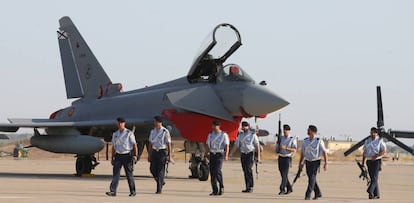Spain commits to boosting military spending by 80% up to 2024
Rise will lift defense budget to around €18 billion, still below 2% of GDP benchmark set by NATO

The Spanish government has committed to increasing its military spending by 80% over the next seven years in order to meet the benchmark set by NATO in 2014. At the NATO Summit in Wales in 2014, members of the 28-nation organization promised to commit 2% of GDP to defense spending. While Spain¡¯s promise to increase spending falls below the 2%, representing between 1.5% and 1.6% of GDP, it equates to around €18 billion in total defense spending.

NATO countries have until December 21 of this year to explain how they will meet the 2014 goal. This goal has become more urgent with the arrival of Donald Trump in the White House. In his first meeting with NATO leaders in May, the US president said NATO countries owed ¡°massive amounts of money¡± and claimed that 23 of the 28 member countries ¡°are still not paying what they should be paying ¡This is not fair to the people and taxpayers of the United States.¡±
The United States, United Kingdom, Greece, Estonia and Poland are the five NATO countries which do dedicate 2% of GDP to defense spending. Spain is one of the last in line, spending 0.92% (2017 forecast), just ahead of Belgium and Luxembourg.
Spain is one of the countries that contributes least to NATO, ahead of just Belgium and Luxembourg
In a letter addressed to NATO secretary-general, Jens Stoltenberg, the Spanish government has explained its plan to increase military spending above GDP growth in the next seven years until this hits €18 billion in 2024. This figure represents an increase of around 80% on the government¡¯s current spending but does not equate to 2% of Spain¡¯s GDP.
Depending on GDP growth and in terms of constant price, the amount could reach between 1.5% and 1.6%. The best possible scenario will see Spain reach the 2% goal by 2028.
The Spanish government believes that with this plan it meets its commitments to NATO, which in Wales, in contrast to what is believed, did not oblige countries to dedicate 2% of GDP to NATO in 10 years. What was agreed upon at that time, was that countries which did not meet this goal should stop military spending cuts and increase defense expenditure in real terms with GDP growth as well as ¡°move towards the 2% guideline within a decade with a view to meeting their NATO Capability Targets and filling NATO's capability shortfall.¡±
The declaration also outlines that NATO countries should spend more than 20% of their defense budgets on major equipment, including related research and development. In this area, Spain is much better positioned as 19.31% of its military spending already goes toward such equipment, according to NATO data.
19.31% of Spain's military budget is spent on equipment
NATO members must dedicate 10% of their defense budget to operations but almost no NATO country meets this goal. Spain has participated in all of the European Union¡¯s military missions ¨C this year it has been the major contributor ¨C and in almost all of the missions led by NATO.
In order to measure the increase in defense spending, it must be first determined whether a spending item can be classified as such. NATO has forecast Spanish spending for 2017 at €10.74 billion, a rise upon 2016 figures (€9 billion, 0.81% of GDP) which dropped as a result of the political stalemate following two general elections.
This figure not only includes the defense budget (€7.7 billion) but also, among other items, foreign operations (€1.1 billion forecast for 2017) and the pensions of retired military members which have social security.
In order to increase military spending and reach the NATO goal, the finance ministry has proposed including the budget of the Civil Guard, an organization which is military in nature. Including the budget of the Civil Guard would add €2.7 billion and increase the GDP percentage by two decimal points. The Ministry of Defense has rejected this as accounting trickery and demanded a real budget increase, but it is logical that the cost of Civil Guard military missions will be included.
Where are Spanish troops deployed?
The Ministry of Defense has asked for "more flexibility" to manage the country's contingents participating in international missions. The ministry wants the freedom to increase the number of troops in Mali, partially reduce the number in Congo and maintain the number of troops deployed internationally, as necessary.
Defense Minister Mar¨ªa Dolores de Cospedal is planning on asking Congress for authorization to increase troop numbers in Mali from from 140 to 292. Spain also hopes to lead a UN mission in Libya and has stated that it would be willing to increase its forces there to 750. In 2018, Spain will also increase its Iraqi contingent with 30 more troops, bringing the number to 480, and send 65 more troops to Afghanistan, bringing the number to 95.
Defense Minister Mar¨ªa Dolores de Cospedal, has asked for advice from the opposition in order to pass a law that protects military spending from political changes and guarantees funding for the duration of armament programs.
The litmus test will be whether the government can pass the 2018 budget. The defense ministry wants to use the €1.82 billion which was included in this year¡¯s budget to pay the outstanding bill for the 2016 and 2017 special armament programs (PEAS) and substantially increase the amount allotted to maintenance ¨C a figure which is seriously in the red. It would be the launch pad for Spain to meet its NATO commitments but the finance ministry has a more pressing priority: getting Spain out of its ongoing debt with the EU.
English version by Melissa Kitson.
Tu suscripci¨®n se est¨¢ usando en otro dispositivo
?Quieres a?adir otro usuario a tu suscripci¨®n?
Si contin¨²as leyendo en este dispositivo, no se podr¨¢ leer en el otro.
FlechaTu suscripci¨®n se est¨¢ usando en otro dispositivo y solo puedes acceder a EL PA?S desde un dispositivo a la vez.
Si quieres compartir tu cuenta, cambia tu suscripci¨®n a la modalidad Premium, as¨ª podr¨¢s a?adir otro usuario. Cada uno acceder¨¢ con su propia cuenta de email, lo que os permitir¨¢ personalizar vuestra experiencia en EL PA?S.
?Tienes una suscripci¨®n de empresa? Accede aqu¨ª para contratar m¨¢s cuentas.
En el caso de no saber qui¨¦n est¨¢ usando tu cuenta, te recomendamos cambiar tu contrase?a aqu¨ª.
Si decides continuar compartiendo tu cuenta, este mensaje se mostrar¨¢ en tu dispositivo y en el de la otra persona que est¨¢ usando tu cuenta de forma indefinida, afectando a tu experiencia de lectura. Puedes consultar aqu¨ª los t¨¦rminos y condiciones de la suscripci¨®n digital.










































